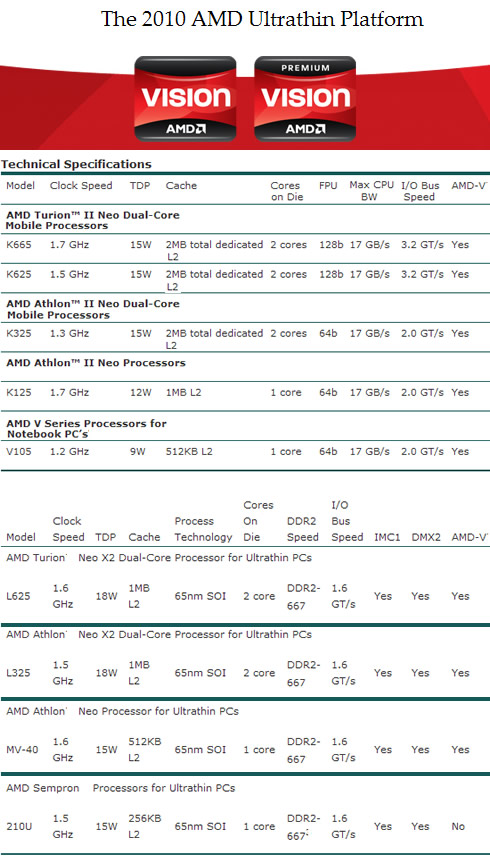
AMD Refreshes Notebook Platforms and Introduces VISION Technology for Desktop PCs
AMD today announced a refresh of its desktop and notebook platforms based on VISION Technology. The new notebook platforms offer up to eight hours of battery life while delivering great graphics and competitive price for the mainstream and ultrathin markets.
"With VISION Technology from AMD, we are finally connecting how people use their PCs with the way people purchase them," said Nigel Dessau, senior vice president and chief marketing officer of AMD. "Today, after little more than 200 days in market, our partners are introducing more VISION-based PCs than ever before; a testament to both the competitiveness of AMD platform technology and the simplified marketing approach."
Introduced in October 2009, VISION Technology from AMD simplifies the PC buying process at the point of sale by focusing on how consumers use PCs, rather than relying upon the "speeds and feeds" technical specifications that many people find difficult to understand. VISION also denotes the visual experience AMD systems enable; an important feature as more consumers use their computers as entertainment hubs for sharing photos, music and videos with friends and family, watching TV and HD videos, and playing games.
The AMD 2010 Mainstream Notebook Platform lets consumers enjoy their movies, music and games, connect with friends on social networks, and edit videos and photos. The 2010 Ultrathin Notebook Platform offers HD playback in affordable notebooks that can deliver up to eight hours of battery life.
AMD claims that its 2010 Ultrathin platform offers the following benefits compared to competitive platforms:
- In testing with HQV 2.0, a VISION-based system with AMD integrated graphics achieved a video experience score almost 2x that of a comparable Intel-based system, AMD claims. Additionally, a VISION-based system with AMD discrete graphics scored 50% better than a comparable Intel-based system with Nvidia discrete graphics.
- The platforms also allows users to enjoy photos with greater color, clarity and definition by cleaning up photos up to 20 percent faster with Adobe Photoshop Elements 8 than competing mainstream notebooks.
- Users will also be able to transfer entertainment fast and convert DVDs to play on game consoles in up to 37 percent less time than a comparable competitive mainstream notebook.
- Up to 80 percent smoother gaming performance in Call of Duty 4: Modern Warfare is also achieved, compared to a comparable competitive mainstream system.
AMD?s new mainstream and enthusiast desktop platforms are designed to deliver superior performance. The new platforms are enhanced with the latest graphics technology for HD digital media and 3D entertainment, and multi-core performance for multi-tasking, including the new six-core AMD Phenom II X6 processor.
Again, AMD compares its new platforms with some competitive offerings:
- Share movies with friends 30 percent faster than with comparable competing PCs.
- Organize digital libraries 40 percent faster, using facial recognition to categorize photos, than competing desktop PCs.
- Build a complete AMD-based system featuring the AMD Phenom II X6 processor with all the necessary components and monitor for less than the price of Intel?s only six-core desktop processor.
Systems featuring these notebook and desktop platforms with VISION Technology from AMD will be available beginning today and through the end of the year from original equipment manufacturers (OEM) and System Integrators including Acer, ASUS, Dell, HP, Lenovo, MSI and Toshiba.
AMD's new CPU lineup for mainstream includes quad, three and dual core versions of the Phenom II, dual-core cores Turion II and Athlon II and the single-core V series.
The Phenom II lineup includes the Phenom II BE X920 (quad-core 2.30GHz), the X620 (dual-core 3.10GHZ), the N930 (quad-core 2GHZ), the P920 (quad-core 1.60GHz), the N830 (tree cores, 2.10GHz), the P820 (three cores, 1.80GHZ) and the N620 (dual-core, 2.80GHz).
A super-thin platform ispowered by three series (Turion II Neo, Athlon II Neo, and V series).
The Turion II series includes the K625 (dual-core, 1.5GHZ, 15W) and the K665 (dual-core, 1.70GHz, 15W) models. The new Athlon II series is based on the K125 (single-core, 1.70GHz, 12W) and the K325 (dual-core, 1.30GHz, 15W). The V series icludes the V105 model (single-core, 1.20GHz, 9W).
The chipset for both the mainstream and super-thin platforms is the AMD M880G. It includes the ATI Radeon HD 4250 graphics bringing support for HD video, Microsoft DirectX 10.1 and ATI Stream Technology.


Introduced in October 2009, VISION Technology from AMD simplifies the PC buying process at the point of sale by focusing on how consumers use PCs, rather than relying upon the "speeds and feeds" technical specifications that many people find difficult to understand. VISION also denotes the visual experience AMD systems enable; an important feature as more consumers use their computers as entertainment hubs for sharing photos, music and videos with friends and family, watching TV and HD videos, and playing games.
The AMD 2010 Mainstream Notebook Platform lets consumers enjoy their movies, music and games, connect with friends on social networks, and edit videos and photos. The 2010 Ultrathin Notebook Platform offers HD playback in affordable notebooks that can deliver up to eight hours of battery life.
AMD claims that its 2010 Ultrathin platform offers the following benefits compared to competitive platforms:
- In testing with HQV 2.0, a VISION-based system with AMD integrated graphics achieved a video experience score almost 2x that of a comparable Intel-based system, AMD claims. Additionally, a VISION-based system with AMD discrete graphics scored 50% better than a comparable Intel-based system with Nvidia discrete graphics.
- The platforms also allows users to enjoy photos with greater color, clarity and definition by cleaning up photos up to 20 percent faster with Adobe Photoshop Elements 8 than competing mainstream notebooks.
- Users will also be able to transfer entertainment fast and convert DVDs to play on game consoles in up to 37 percent less time than a comparable competitive mainstream notebook.
- Up to 80 percent smoother gaming performance in Call of Duty 4: Modern Warfare is also achieved, compared to a comparable competitive mainstream system.
AMD?s new mainstream and enthusiast desktop platforms are designed to deliver superior performance. The new platforms are enhanced with the latest graphics technology for HD digital media and 3D entertainment, and multi-core performance for multi-tasking, including the new six-core AMD Phenom II X6 processor.
Again, AMD compares its new platforms with some competitive offerings:
- Share movies with friends 30 percent faster than with comparable competing PCs.
- Organize digital libraries 40 percent faster, using facial recognition to categorize photos, than competing desktop PCs.
- Build a complete AMD-based system featuring the AMD Phenom II X6 processor with all the necessary components and monitor for less than the price of Intel?s only six-core desktop processor.
Systems featuring these notebook and desktop platforms with VISION Technology from AMD will be available beginning today and through the end of the year from original equipment manufacturers (OEM) and System Integrators including Acer, ASUS, Dell, HP, Lenovo, MSI and Toshiba.
AMD's new CPU lineup for mainstream includes quad, three and dual core versions of the Phenom II, dual-core cores Turion II and Athlon II and the single-core V series.
The Phenom II lineup includes the Phenom II BE X920 (quad-core 2.30GHz), the X620 (dual-core 3.10GHZ), the N930 (quad-core 2GHZ), the P920 (quad-core 1.60GHz), the N830 (tree cores, 2.10GHz), the P820 (three cores, 1.80GHZ) and the N620 (dual-core, 2.80GHz).
A super-thin platform ispowered by three series (Turion II Neo, Athlon II Neo, and V series).
The Turion II series includes the K625 (dual-core, 1.5GHZ, 15W) and the K665 (dual-core, 1.70GHz, 15W) models. The new Athlon II series is based on the K125 (single-core, 1.70GHz, 12W) and the K325 (dual-core, 1.30GHz, 15W). The V series icludes the V105 model (single-core, 1.20GHz, 9W).
The chipset for both the mainstream and super-thin platforms is the AMD M880G. It includes the ATI Radeon HD 4250 graphics bringing support for HD video, Microsoft DirectX 10.1 and ATI Stream Technology.























